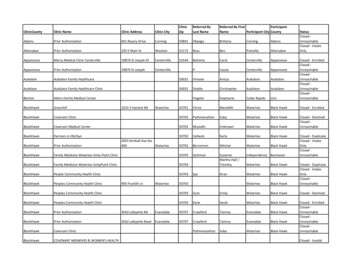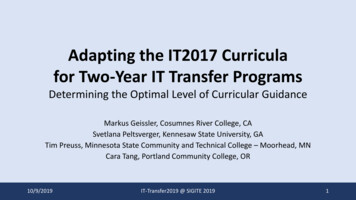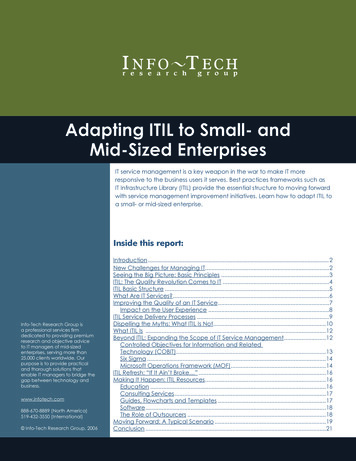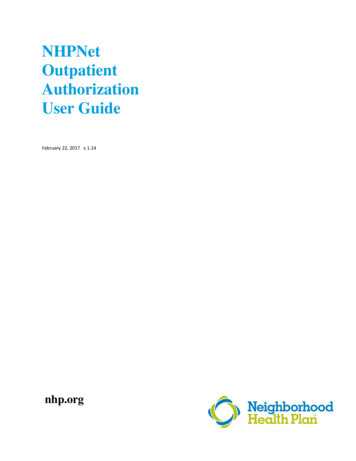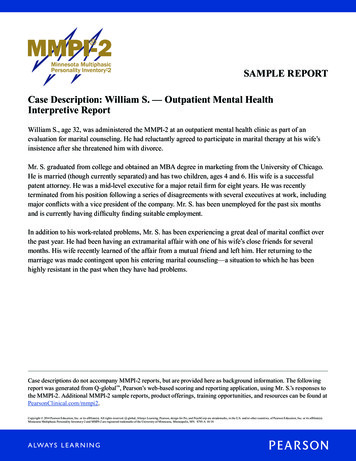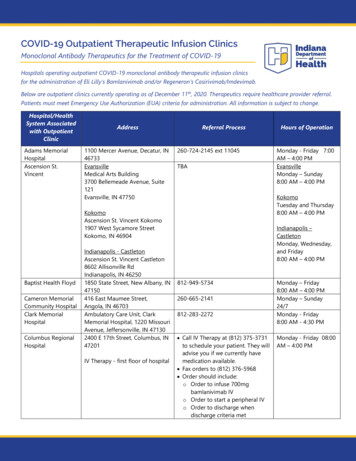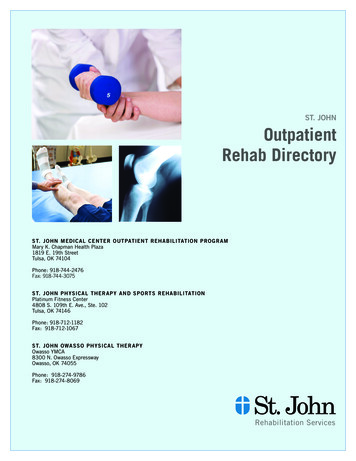
Transcription
JOURNAL OF MEDICAL INTERNET RESEARCHSasangohar et alViewpointAdapting an Outpatient Psychiatric Clinic to Telehealth During theCOVID-19 Pandemic: A Practice PerspectiveFarzan Sasangohar1, BA, BCS, MASc, SM, PhD; Major R Bradshaw2, BS, PhD; Marianne Millen Carlson2, BS, MA,PsyD; James N Flack2, BA, MD; James C Fowler2, BA, PhD; Diana Freeland2, BA, MA; John Head2, BM, MM,MT-BC, NMT; Kate Marder2, BA, MA; William Orme2, BS, MA, PhD; Benjamin Weinstein2, BS, MD; Jacob MKolman1, BA, MA; Bita Kash1, BS, MBA, PhD; Alok Madan2, BA, MA, MPH, PhD1Center for Outcomes Research, Houston Methodist Hospital, Houston, TX, United States2Behavioral Health Clinic, Houston Methodist Hospital, Houston, TX, United StatesCorresponding Author:Farzan Sasangohar, BA, BCS, MASc, SM, PhDCenter for Outcomes ResearchHouston Methodist Hospital6565 Fannin StHouston, TXUnited StatesPhone: 1 979 458 2337Email: sasangohar@tamu.eduAbstractAs the demand for telepsychiatry increases during the COVID-19 pandemic, the strengths and challenges of telepsychiatryimplementation must be articulated to improve clinical practices in the long term. Currently, observations within US contexts arelacking; therefore, we report on the rapid implementation of telepsychiatry and workflow experiences in a psychiatric practicebased within a large health care system in southeast Texas with a national catchment area. We discuss the logistics of theimplementation, including modes of communication, scheduling, coordination, and capacity; the psychological effects of web-basedservices, including both the loss of the physical therapeutic environment and the unique interpersonal dynamics experienced inthe virtual environment; and postadoption patterns of engagement with our services and with other clinical functions affected bythe rapid adaptation to telemedicine. Our art therapy group programming serves as an applied case study, demonstrating the valueof a well-managed web-based program (eg, patients were receptive and well-engaged, and they appreciated the continuity ofaccessible service) as well as the challenges (eg, the need for backup plans and technological fallbacks, managing interruptionsand telecommunication learning curves, and working around the difference in resources for art and music therapy between awell-stocked clinical setting versus clients’ home spaces). We conclude from our experience that the overall strengths oftelepsychiatry include receptive and well-engaged responses from patients as well as the expansion of boundaries, which providesa directly contextualized view into patients’ home lives. Challenges and corresponding recommendations include the need formore careful safety planning for high-risk patients; maintaining professional boundaries in the newly informal virtual setting;designing the physical space to both frame the patient encounter and maintain work-life balance for the therapist; allowing fordelays and interruptions (including an initial acclimation session); and preserving interprofessional care team collaboration whenthe physical locations that normally facilitate such encounters are not accessible. We believe that careful observations of thestrengths and challenges of telepsychiatry during this pandemic will better inform practices that are considering telepsychiatryadoption both within pandemic contexts and more broadly thereafter.(J Med Internet Res 2020;22(10):e22523) doi: 10.2196/22523KEYWORDStelemedicine; psychiatry; preventive psychiatry; SARS virus; pandemic; prevention; COVID-19; telehealth; perspectivehttps://www.jmir.org/2020/10/e22523XSL FORenderXJ Med Internet Res 2020 vol. 22 iss. 10 e22523 p. 1(page number not for citation purposes)
JOURNAL OF MEDICAL INTERNET RESEARCHIntroductionThe spread of COVID-19 and wide-scale self-quarantine andshelter-in-place orders have led many nonemergency practicesto adopt telehealth solutions to continue serving their patients[1], and psychiatry is no exception. While some cases will stillwarrant inpatient psychiatric admissions, including coordinatedcare for psychiatric inpatients who test positive for COVID-19[2], telepsychiatry is a viable option for handling outpatientscenarios. Best practices are already in place [3], and there is asupportive evidence base for telepsychiatry [4-6], particularlyfor web-based therapy for depression [7] and posttraumaticstress disorder [8]. However, the forced adoption of and masstransition to telehealth during the COVID-19 pandemic hasresulted in significant challenges for the implementation oftelehealth for psychiatric services [9,10]. While guidelines existfor postpandemic telepsychiatry [11,12], given the uniquecharacteristics of this COVID-19 pandemic, lessons learnedfrom these transitions as well as implementation-specificguidelines would be highly applicable to other practices. Todate, clinical implementations and lessons learned (and withlargely positive results) have been reported largely from settingsoutside the United States, such as China [13,14], Europe [15-23],Turkey [24], and Australia [10,25-28], with only some UScoverage (notably [9], [29], and [30]). In this paper, wedocument our experience with telehealth adoption at a psychiatrypractice embedded in a large health system in the United Statesand summarize several important successful improvisations andchallenges to support broader and more diverse adoption efforts.Established in January 2018, the psychiatric outpatient clinicat Houston Methodist Hospital offers programs of care toaddress gaps in the current mental health treatment continuum.The therapeutic outpatient assessment services spanapproximately 10 business days (2 to 4 hours per day) and aretailored to patients with complex and persistent psychiatricconditions, including depression, anxiety-related disorders,trauma, psychosis, interpersonal dysfunction, chronic pain, sleepdisorders, emotional regulation problems, and suicidality. Theteam-based, multidisciplinary assessment is designed to optimizeinsight, produce maximal diagnostic clarity, and create aroadmap for future treatment.The clinic offers access to mental health care through a 5-weekFunctional Rehabilitation Program that includes morning grouptherapy sessions and individual sessions in the afternoon. Theprogram proceeds on an outpatient basis, enabling patients tocomplete treatment while remaining engaged with their lives.The approach to treating patients incorporates an understandingof broader contexts, such as medical comorbidities and socialdeterminants of health. The clinic also offers services to meetthe varied and dynamic needs of our patients, including anintensive outpatient program, a modified functionalrehabilitation program, individual psychotherapy, couplescounseling, psychotropic medication management, and art andmusic therapies.In some ways, our clinic had a “head start” on the COVID-19pandemic compared to most other clinics, as it was alreadytransitioning to digital platforms before the pandemic [31]. Thehttps://www.jmir.org/2020/10/e22523XSL FORenderXSasangohar et alsystem-wide support for innovative technologies in our healthsystem had resulted in early adoption of and significantinvestments in telehealth, including secure and integratedtechnology to facilitate virtual visits embedded within ourelectronic health record (EHR), a virtual intensive care unit[32], and adoption of telemedicine postoperative follow-up [33].We had already vested and integrated a platform calledCareSense (MedTrak, Inc) for previsit and postvisit carecoordination and patient-reported outcomes (see [31] and Fowleret al, forthcoming). Hence, frequently cited sources of providerhesitation to adopt telemedicine, including workflow integrationand infrastructure-related logistics [4,34-37], did not apply toour practice or to our overall culture. However, the COVID-19pandemic still necessitated rapid adoption of changes to go livebefore full testing.Implementation and ExperiencesOn March 18, 2020, our outpatient clinic transitioned to a 100%telehealth platform, and it is continuing with this approach asof this writing. Our complete transition and continued use oftelehealth technologies contrasts with many other outpatientpractices, where clinics have followed suit with local businessesand have opened to provide at least some in-person treatment.We chose a more conservative approach to the ongoing use oftelehealth technologies for many reasons. Hospital-wide policiesrequire face masks and six feet of social distancing for alloutpatient visits for both patients and providers. These safetyrequirements reduce the risk of COVID-19 transmission butcome at a significant cost to the daily practice of outpatientpsychiatric care. Our assessments and interventions rely heavilyon nonverbal and verbal communication. Masks cover well overhalf of patients’ faces, limiting providers’ assessment of patientaffect. Additionally, masks muffle voices. This facet ofmask-wearing has the potential to negatively affect the contentof verbal output and subsequently affect comprehension forpatients and providers alike. Verbal communication from atleast six feet away only worsens the potential negativeconsequences of muffled voices.Diversifying Modes of Communication: One Size DoesNot Fit AllIn our practice, we found it essential to leverage multipleplatforms and modalities (eg, Cisco Webex, Microsoft Teams,email, telephone calls, the EHR, patient portal communications)to facilitate the initial transition. While such an inclusive strategymay increase the logistical complexity of care for the providers,our clients found the backup options and redundant systems tobe essential. For instance, one client became anxious andfrustrated by initial difficulties downloading Webex; therefore,we pivoted to using FaceTime (Apple Inc), which did not requirean additional tool and was familiar to the client. Another client,who was feeling lonely and disconnected but struggled to findtime for sessions because of childcare demands, was able tofeel connected by occasionally texting her therapist. The textsincluded YouTube links to humorous videos on shared pandemicstruggles. In addition to serving a wide range of clientpreferences, this flexibility was key to help us maintain theavailability of service even when one modality lagged or becameJ Med Internet Res 2020 vol. 22 iss. 10 e22523 p. 2(page number not for citation purposes)
JOURNAL OF MEDICAL INTERNET RESEARCHunresponsive. In addition, having different levels of fidelity onhand (eg, from high-tech Webex to low-tech telephone calls)created a scaffold for backup options and platforms that can beused in tandem. Of course, a list of both COVID-19–provisionalapproved applications and technology that is more generallycompliant with the Health Insurance Portability andAccountability Act (HIPAA) should be consulted to ensuredigital security and privacy [38].Conversely, diversifying the modes of communication alsocarries efficiency costs (both within the care team and inteam-client interactions). These include logging in to platformsand waiting for others to do the same; pausing for deliberatetransition between speakers; and reporting the same informationin different forms and in multiple places (eg, rapid switchesbetween sessions on Microsoft Teams and formal documentationof the same in the EHR).Special Logistical ConcernsHandoff procedures were particularly transformed in the newprocess. Using the gaps between sessions for quick handoffsresults in moving from meeting to meeting without a break andthen ending the day with more in-depth documentation. Weexperienced an increased need for communication between teammembers; casual hallway or “water-cooler” handoffs frequentlyoccur in physical clinic settings, but these could not occur whenthe care team shifted to telecommuting. Some team membersadapted to the loss of this natural and implicit means ofcoordination by more explicit efforts, while others “went silent.”We learned that staff should consciously expect and prepare forthese easily underestimated differences in communicationdynamics.Management of schedules and appointment times was also morestressful and demanding, as tardiness or absence fromappointments became ambiguous. An office no-show can occurfor many reasons but at least is always counted as an absence.Web-based absence can result from an otherwise ready clientexperiencing technical difficulties, a broken or misdirected link,or an adjacent appointment; other no-show reasons includeforgetfulness or distractions due to other turmoil(quarantine-related or otherwise). In addition, team members’and clients’ free time has been transformed, limited or expanded,and distributed differently due to lockdown. Factors such aschildcare, other caregiver needs, or the presence or absence ofother adults in the home have become factors that affectschedules.Finally, we found that team members and clients had variablecapacity to formulate their communication behaviors andsubsequently adapt them to the virtual leap. Technologicalcomfort, literacy, and fluency also played roles. When finallyonline, users experienced differences in the conversational flowin the web-based environment and had to adjust theirinterviewing styles, such as avoiding talking over the patient.Video exists in a liminal space between in-person interactionand nonvisual interaction. When face-to-face, interlocutorsexperience familiar nonverbal cues to signal when a speaker isfinished or when a listener is still attentive or becomingunsettled, which informs the turn order of speaking as needed;in radio communications, there is a clear expectation that thesehttps://www.jmir.org/2020/10/e22523XSL FORenderXSasangohar et alcues will be absent (hence, conventions are in place such assaying “over” to replace the cues). Web-based video lacks thefidelity to retain the cues but “teases” users with at least somevisual context; therefore, we may not properly reset ourexpectations (nods are missed in choppy video feeds, pitch cuesare missed in the audio transmission, eye contact is disruptedby the offset camera eye, etc.). Delays in communication asspeakers are confused by the turn order affect the length andefficiency of the session, and more time is required to buildrapport and trust with new patients.Psychological Effects of Web-Based Audiovisual ChatOur clinic emphasizes differentiation through “time and team”to produce a therapeutic effect. With telehealth, we need to bemore mindful of the “time” aspect, which as noted above hasbeen transformed. Web-based chat fatigue (also referred to as“Zoom fatigue” during the COVID-19 pandemic) of patientsand team members has sometimes motivated us to limit theduration and frequency of sessions to spread out the mentaleffort required. Patients still receive the time that our clinicpromises; however, they may need to be more flexible with theduration of our programs. As a team, we do not have as muchtime to talk about patients together because we are confined toteam meetings and have strict cutoff times and schedules beforethe next Webex meeting begins. We also miss the in-personconsultations between staff, which have social and not purelylogistical benefits. For both our clients and health care workers,a well-established period of reflective time can be as therapeuticand rejuvenating as any sacred or holy space [39]; therefore,the fragmentation of that time into asynchronous processes suchas emails is felt. We have used other technology formats andcall or text providers as needed to communicate. The neededinformation is communicated; however, these consultations arequick and detailed information is lost.Time and space coalesce to form a therapeutic environment formental health. Space is now virtual, with sessions taking placein the patient’s home or home office in a manner contiguouswith the rest of their day. Thus, they can lose the effect ofrelocating to a separate and unique space, such as thepsychiatrist’s office. In this new space, team members andclients have needed to work harder to generate and sustaininterpersonal connection. Social signals and efforts must beamplified to overcome the loss of intimacy and belongingderived from physical proximity. This is difficult when newrelationships begin in the virtual environment, in contrast toexisting clients, with whom rapport was already establishedbefore the transition to virtual sessions. Conversely, video chatgarners some closeness because of the virtual invitation intonormally private spaces (eg, the therapist’s and client’s homeoffice or kitchen table). Viewers obtain unintended but inevitableglimpses into each other’s home lives (children, pets, spousesroaming in the visual or audio background) [40], and even dresstends to be less formal.Services and Service Lines Under TelehealthWe carefully scrutinized which services can transition withoutan unacceptable loss of integrity and which cannot. Individualtherapy is an easy and established service for telehealth [5,7];group therapy has been received well by providers and clientsJ Med Internet Res 2020 vol. 22 iss. 10 e22523 p. 3(page number not for citation purposes)
JOURNAL OF MEDICAL INTERNET RESEARCHalike, perhaps because the program is small. Art and musictherapy programs had precedents; however, the success oftransition was uncertain, and exploratory efforts were requiredto establish workability, as in our case study below.Neuropsychological services had to be limited to simplescreening. These choices were determined by individualworkplaces but should not arise in a vacuum.Some programs may thrive more during quarantine than theyotherwise would via telemedicine or other modes. Namely, wesuspect that people are currently happy to connect in groupprograms because they are not seeing anyone else due toquarantine. Although there are still some technologicalchallenges, patients are glad to have a social space. Once clientsre-engage with their normal social supports and are notquarantined, participation in group sessions may decrease.Specific functions of our psychiatric practice have also beentransformed. Some psychological testing can now be completedthrough vendor-supplied web-based portals. Other tests requirea physical presence, such as medical tests, genetic testing, andmagnetic resonance imaging (MRI), and therefore present achallenge. More time is needed to order these tests and to receiveresults. We no longer have the luxury of ordering andcoordinating care within our system. We must rely on externalfacilities, and relevant information is not always readilyavailable in our EHR. Releases of information and other paperforms must be completed by hand, scanned by patients, andthen emailed to us. Fillable forms (eg, smart PDFs) are moreefficient and easier for patients who may lack access totechnology or suitable home office supplies.Case Study: Art/Music Therapy GroupArt and music therapies are integral components of our uniquelystructured Functional Rehabilitation Program; all patientsparticipate in these forms of therapy in both individual andgroup settings. While more common forms of psychotherapyare also features of the core clinical programming (eg,acceptance and commitment therapy, dialectical behavioraltherapy skills training, process-oriented group therapy), wechose to highlight art and music therapy because of theadditional logistical challenges these therapies required intransitioning from in-person sessions to a telehealthplatform—namely, the need for therapy-specific equipment,such as painting supplies and musical instruments.The first tele–art therapy group was held by telephone ratherthan video due to technical difficulties. While it was difficultto conduct an art therapy group session without being able tosee anything, the planned session included a writing prompt,and patients were able to share what they had written along witha description of what they had started to create (demo
technology to facilitate virtual visits embedded within our electronic health record (EHR), a virtual intensive care unit [32], and adoption of telemedicine postoperative follow-up [33]. We had already vested and integrated a platform called
